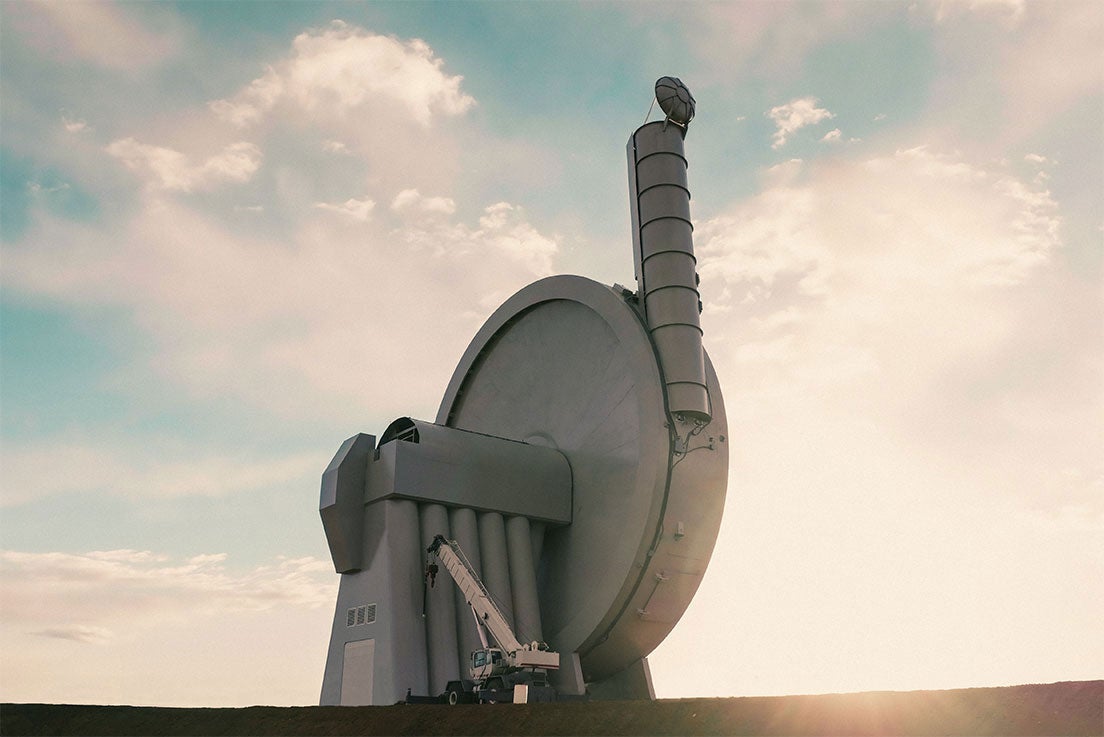NASA is planning to test an unconventional system for launching small objects to low Earth orbit. The system, which uses intense centrifugal force and a final propulsion stage, aims to make launches more affordable and environmentally friendly, but the concept remains unproven.
SpinLaunch has been running tests of its system in the New Mexico desert for the past several months, and we certainly took notice of the California startup when it performed a successful first test on October 22, 2021, when the A-33 Suborbital Mass Accelerator — working at just 20% capacity — flung a 3.05 m-long projectile to an altitude of tens of thousands of feet, according to the company.
The current suborbital accelerator is a one-third scale version of the machine SpinLaunch would like to build — a gigantic kinetic launch system capable of hurling objects to the edge of space. Flung to an extreme altitude, the projectile’s propulsion stage would kick in, providing the final boost to low Earth orbit (LEO). The system, should it work, would introduce an entirely new means of delivering objects to space, as potential payloads could include small satellites, on-orbit scientific experiments, building materials, or even the ashes of loved ones.

So yes, SpinLaunch nabbed our attention, and the concept seems to have caught NASA’s eye as well. The space agency has signed an agreement with SpinLaunch to develop, integrate, and fly a NASA payload spewed out by the company’s A-33 Suborbital Mass Accelerator, according to a press release. This test could happen as early as later this year. SpinLaunch would also be required to recover the payload, followed by a combined analysis to evaluate the test and determine whether the space agency would like to proceed with subsequent tests.
The NASA Space Act Agreement with SpinLaunch is part of the agency’s Flight Opportunities Program, which gets funding from NASA’s Space Technology Mission Directorate. The purpose of this program is to quickly demonstrate promising tech for “space exploration, discovery, and the expansion of space commerce through suborbital testing with industry flight providers,” according to NASA.
SpinLaunch has been around since 2014, and it’s aiming to deliver small payloads to LEO by 2025. To that end, it’s been working with Airbus, Google Alphabet, Kleiner Perkins, and other private companies, and now NASA. In the press release, Jonathan Yaney, founder and CEO of SpinLaunch, said his company offers “a unique suborbital flight and high-speed testing service, and the recent launch agreement with NASA marks a key inflection point as SpinLaunch shifts focus from technology development to commercial offerings.”
OK, whoa, whoa, whoa. The new agreement is obviously an exciting development for the company, but Yaney needs to pump the brakes. SpinLaunch has yet to place an object in orbit, and it’s not immediately clear if a scaled-up version of the accelerator will work as intended. There’s also the final propulsion stage to consider, and the oh-so-delicate task of placing payloads in their proper orbits. Speaking of payloads, they’ll have to survive the journey to space, not to mention the intense spinning inside the accelerator prior to discharge.
Indeed, the g-forces promise to be intense, as speeds within the scaled-up orbital version of the accelerator are expected to reach 8,047 km per hour. A launch vehicle carrying a satellite or other cargo (no humans, obviously) will be positioned at the tip of a rotating carbon-fibre arm located within a 91-metre steel vacuum chamber. The arm, moving counterclockwise, will spin increasingly faster until it’s ready to shoot the object through the smokestack-like tunnel at the top of the accelerator. Once in the stratosphere, the launch vehicle will engage its thrusters to complete the journey to orbit. The company expects to launch satellites weighing upwards of 200 kg.

The company claims the system will result in a 70% reduction in the use of fuel compared to conventional rockets and a 10-fold reduction in the overall cost to launch. The accelerator uses an electric engine, making it considerably more environmentally friendly than the alternative. SpaceLaunch says many components of the system are built from existing industrial hardware and that no radical advancements in technologies or materials are required. As an added bonus, a single facility could perform multiple launches each day. Accordingly, SpaceLaunch is positioning the system as a clean, cheap, and efficient way for companies to populate LEO with satellites and to build satellite megaconstellations.
In addition to efficacy, SpaceLaunch will have to prove safety, such as demonstrating the ability to detonate a wayward projectile. The company will inevitably run into the Federal Aviation Administration, which needs to ensure the safety of U.S. assets during commercial launches. This will all take time, but having NASA involved is an instant credibility win for the young company. It’ll be fascinating to see how this promising concept evolves from here.
